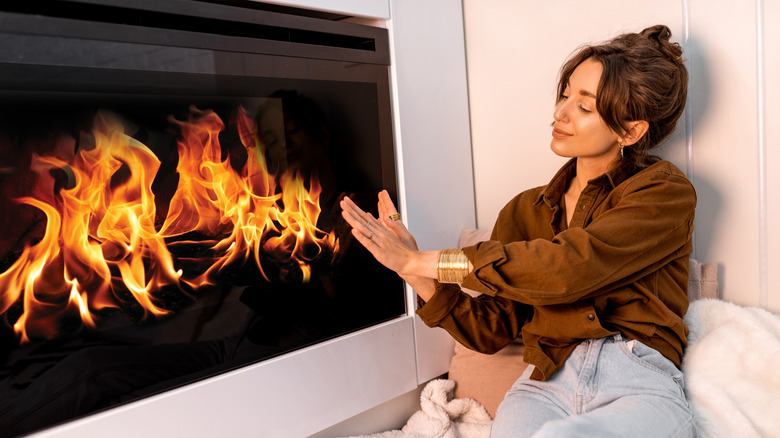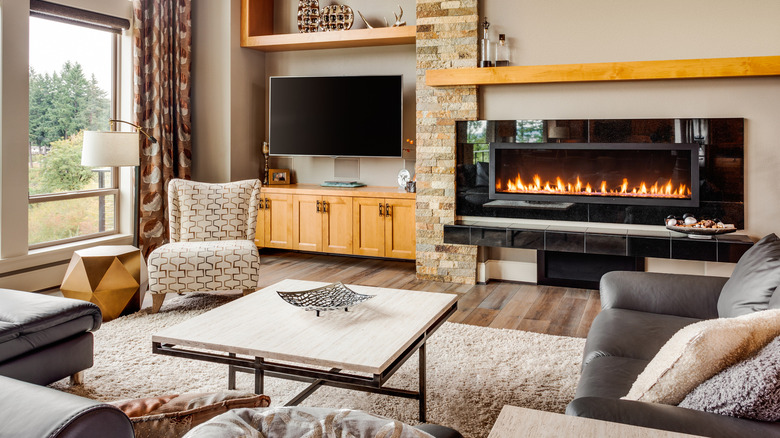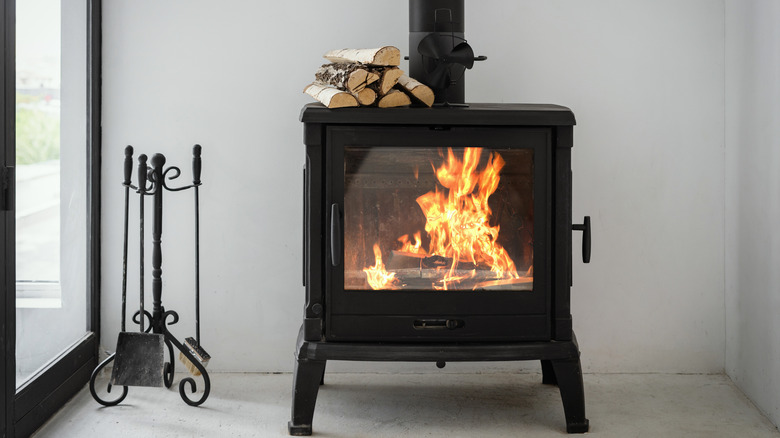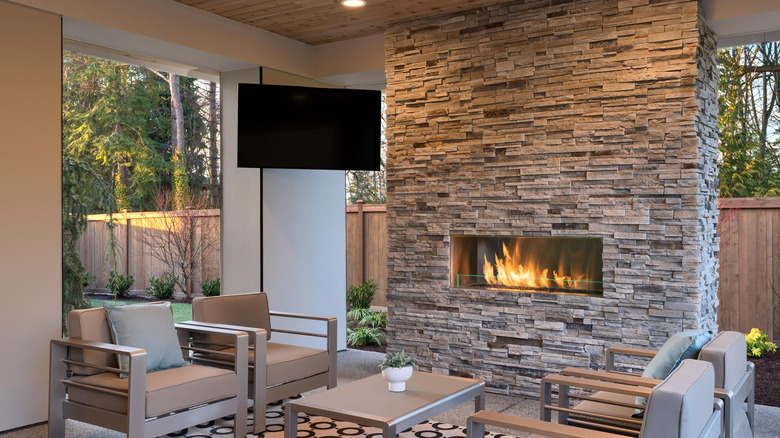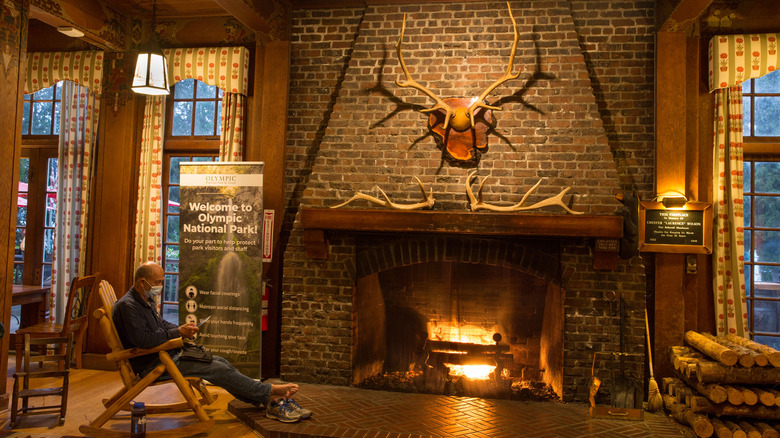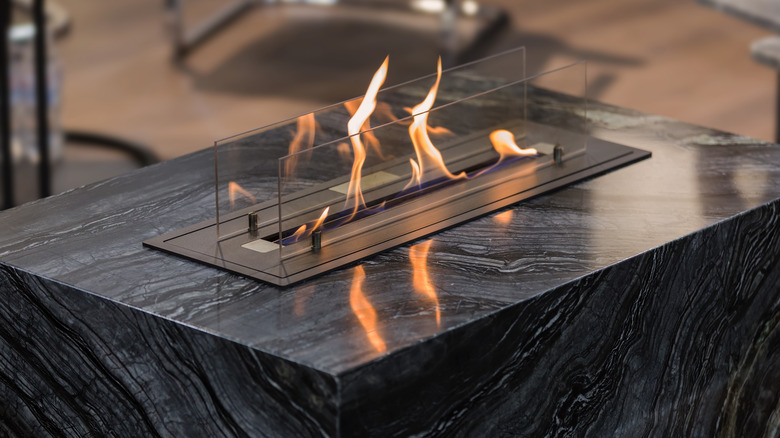Gas Fireplaces: What To Know Before You Buy
We may receive a commission on purchases made from links.
If you happen to live in one of the most freezing places out there, like Russia, Canada, North Dakota, Poland, or Alaska (via Wow Travel), you'd notice that the historical homes around you probably have a fireplace –– heck, they have a few fireplaces –– or they'd have frozen ages ago. But let's say your home isn't a historical one; even if it's newly built, you want to avoid those soot-spitting and wall-darkening wood fireplaces — seriously, what year is this?
Earlier on, we spoke about what you need to know before buying a ventless gas fireplace, and while that was enlightening, we thought it wise to do an all-inclusive piece because there is more to gas fireplaces than simply the ventless gas version. You'll see what we mean shortly. Even if you do not live in locations that are constantly cold all year long, winter will hit. And, if you want the best bonding experiences with your family, you want, at some point, everyone sitting at the fireplace with their toes curled up, hot cocoa mug in hand.
There are a couple of alternatives to the gas fireplace such as gas inserts and gas logs, writes Croft Fireplace. So, to help you make an informed decision when building your home, renovating, or even indulging in new structural arrangements, we have put together a collection of everything you need to know before buying a gas fireplace: why should you buy one, what size or type is a perfect fit for you, and more.
What is a gas fireplace?
A gas fireplace is simply a fireplace that runs on gas or propane rather than the old traditional wood to warm up a home. Croft Fireplace writes that this improvement on the old gathering wood fireplace imitates the look and feel of the traditional fireplace. However, it does not provide you the full experience though; you'll miss out on the experience of gathering and the trouble of burning wood — if you ask us, we think that is a win.
You see, there are multiple styles and alternatives to choose from when it comes to purchasing a gas fireplace. Regency writes that you could purchase a gas insert, which is perfect for renovating an old traditional fireplace, or a gas stove, which is great as an afterthought or an added heat source. And, This Old House tells us about logs which are aesthetically similar to wooden fireplaces, but the wood is made of ceramic and gas outlets have been drilled in the bottom. If neither of the above appeal to you, built-in fireplaces that do not require an existing fireplace structure should. Furthermore, there is also a venting system that comes with gas fireplaces and they can be summed up as vented or ventless fireplaces.
Types of gas fireplaces
When it comes to categorizing the types of gas fireplaces, we are talking about the make structure and venting structure. In the make structure, we will be looking at the gas insert, the gas stove, the gas logs, and the gas built-ins. And for the vents, we'll discuss the making of vented and ventless fireplaces. Here, we have discussed four different make structures.
The primary deal with gas inserts is that they solve the problem of heat circulation that comes with traditional fireplaces. According to VanderWall Bros, traditional fireplaces only warm up the areas near the burning wood. However, with gas inserts, which are built with a venting system, a heat-conducting metal shell, and sometimes a blower, all the heat and energy being produced gets pushed back into your home.
Regency writes that a gas stove fireplace is one that can be placed in the existing fireplace structure or any other part of the home to provide heat. We think that this is a great secondary source of heat because it is portable and mobile. Fireplace Direct backs us up when we said that fireplace logs are a great aesthetic quality to add to your home as they model the antique wooden fireplace by having ceramic logs, as well as a burning system underneath where the fire comes on. This type of gas fireplace can either be vented or ventless, so you have a choice.
Finally, with the gas built-in fireplace, if you desire a gas insert fireplace but your home lacks the existing structure of a traditional fireplace, you should consider the built-in version; they look and function just the same except that the air is circulated through an exterior opening in the wall, writes The Old House.
How to choose the perfect gas fireplace for your home
We, being passionate about décor will recommend a gas fireplace that aligns with the interior aesthetic of your home. Four Day Fireplace writes that you should choose a much more modern design if your home is well, modern, but if your home is historic, you should go for an antique design. Besides, you need to make use of the existing traditional fireplace! Also, since you want every part of your home warm and toasty in the winter, you should choose a gas fireplace whose heat capacity or BTU aligns with the needed energy for your home, writes Bob Vila.
Furthermore, you want to consider energy input and output. Are you using propane or natural gas, and do you want/can your home accommodate a vented or a ventless gas fireplace? Leffler Energy writes that you want to consider costs, output energy, and of course, the environment when choosing between propane and natural gas. A cubic foot of propane delivers about 2,516 BTUs, which is over twice the amount of BTUs a cubic foot of natural gas produces. Propane is more cost-efficient than natural gas, but it causes more damage to the earth.
Finally, you want to consider the appearance and functionality of your gas fireplace. Do you want to place furniture or appliances above your fireplace? How will you style your gas fireplace? Do you want to place it in unconventional areas like a patio or above a bathtub?
How long does a gas fireplace last?
Like everything else, gas fireplaces of whatever making or venting style do not last forever. If you did thought that they did, we would like to not apologize for bluntly debunking that. However, according to Croft Fireplace, your gas fireplace should last a little over 10 years, and it'll be a miracle if it works anything more than 15 full years.
However, you should bear in mind that these life expectancy dates depend solely on how often you use the gas fireplace. For instance, if you live in areas where the temperatures are only slightly below freezing 365 days a year, you obviously will use your fireplace longer than the fellow who uses theirs about 100 days a year during winter. And, that fellow still uses theirs more than businesses who use theirs mainly for décor. Small riddle: Whose gas fireplace will last longer? Yes, exactly, the business' unit.
If your gas fireplace has issues before its expected 10- to 15-year lifespan, you really should consider a repair rather than a replacement to save funds. However, if you plan on reselling the home, you may want to consider a replacement because iBuyer says that adding one can increase the resale value of your home by a whopping $12,000.
Pros and cons of a gas fireplace
There's no point purchasing a gas fireplace if it has no substantial benefits. We mean, there are reasons why you might as well retain your old wood fireplace or purchase an electric one rather than a gas version. So briefly, we would like to inform you about the pros and cons of getting a gas fireplace of any type installed in your home.
For us, first on the list is the fact that we do not have to deal with the exhaust fumes of burning wood, and do not get us started on the need to clean the chimney of a traditional gas fireplace, per Petro. Next, the gas fireplace excites us because it is very convenient to use (really all it takes is the tap of a button), writes Rep-Air Heating and Cooling. Furthermore, the gas fireplace pollutes the environment way less than traditional fireplaces do; there is seriously no residue or ash or soot left behind. Plus, they are highly mobile and can be planted literally anywhere in the home, writes American Chimney and Masonry.
Enough of the pros, the gas fireplace is not without its cons. Before purchasing, you should consider the long-term continued costs of propane or natural gas, writes Fireplace Tips. Seriously, is this something you want to add to your budget? Or a cost you can conveniently fit in without any hassle? Also, you do not get to enjoy the much-coveted crackles, hissing, and the roaring flames of a traditional fireplace, says American Chimney and Masonry.
All about gas fireplace costs
A gas fireplace's initial cost is centered on purchase and installation. Other costs you may incur during use are gas costs, replacement costs, and repair costs when the need arises. So, to give you an overview of what your budget should look like, read on.
Fireplace Town estimates the gas fireplace insert to be anything between $800 and $1,500; anything above that, you're being ripped off. The initial cost of a gas log fireplace should be only $250, as noted by Costimates. On the other hand, according to Four Day Fireplace, if you are seeking to purchase a portable gas stove fireplace, you should budget anything between $3,000 and $4,500. Logically, replacement costs should be the same as initial purchase and installation costs.
Although Installation cost varies, Forbes writes that it will depend on the intricacies and the model of your home, but should cost you $3,500 maximum. For operating costs, the cost of gas you purchase yearly will be between $556 and $1,112 every year, barring inflation or hikes in the price of gas, says Regency.
Finally, repair costs for any gas fireplace are determined by the level of damage incurred. However, Home Advisor tries to narrow this down and claims that you should budget $177 to $2,000 for repairs, especially in the winter. You do not want to have the fireplace breaking down when you need it the most.
Three top gas fireplace brands
First, if you are seeking to purchase a gas insert, we would recommend the Napoleon Grandville VF Series GVF36-2N 37" because it was handpicked as one of Bob Vila's top fireplaces. It was also reviewed by verified purchasers and users on Amazon and determined to be a great source of heat and of course, value. Napoleon writes that this is a heavy-duty gas fireplace because it has an output of about 30,000 BTU. This product comes at around $1,500 to $1,600.
Another great pick if you are into direct venting (a venting system with two vents: one for receiving in air and the other for letting out harmful gas emissions) gas fireplaces is the White Mountain Hearth Boulevard Direct Vent Linear Fireplace. It was handpicked as one of Fireplace Direct's finest gas fireplaces and should be your go-to option. This product is reputed to produce a maximum of 34,000 BTU, thereby keeping your home warm all the time, per White Mountain. This product costs around $8,000 to $9,000.
Lastly, the Empire Tahoe Deluxe Direct Vent Natural Gas Fireplace, which took a royal stride into Find This Best's list of top fireplaces to purchase for your home, is an all-round excellent pick for compact spaces. This is because of its style, aesthetics, and ability to produce 20,000 BTUs, says the eFireplace Store. Also, according to North Country Fire, this brand supports both the use of natural gas and propane, and it costs $1,400 to $1,600.
